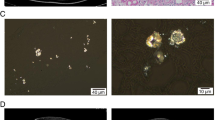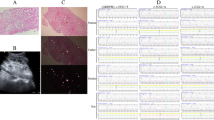Abstract
Primary hyperoxaluria is a rare autosomal recessive inborn error of metabolism with three known subtypes. In primary hyperoxaluria type 1, the most common of the subtypes, a deficiency in the hepatic enzymes responsible for the metabolism of glycoxylate to glycine, leads to excessive levels of glyoxylate, which is converted to oxalate. The resultant elevation in serum and urinary oxalate that characterizes primary hyperoxaluria leads to calcium oxalate crystal deposition in multiple organ systems (oxalosis). We review the genetics, pathogenesis, variable clinical presentation and course of this disease as well as its treatment. Emphasis is placed on the characteristic imaging findings before and after definitive treatment with combined liver and renal transplantation.







Similar content being viewed by others
References
Knight J, Jiang J, Assimos D et al (2006) Hydroxyproline ingestion and urinary oxalate and glycolate excretion. Kidney Int 70:1929–1934
Pey AL, Albert A, Salido E (2013) Protein homeostasis defects of alanine-glyoxylate aminotransferase: new therapeutic strategies in primary hyperoxaluria type I. Biomed Res Int. doi:10.1155/2013/687658
Diallo O, Janssens F, Hall M et al (2004) Type 1 primary hyperoxaluria in pediatric patients: renal sonographic patterns. AJR Am J Roentgenol 183:1767–1770
Cochat P, Rumsby G (2013) Primary hyperoxaluria. N Engl J Med 369:649–658
Beck BB, Hoyer-Kuhn H, Göbel H et al (2013) Hyperoxaluria and systemic oxalosis: an update on current therapy and future directions. Expert Opin Investig Drugs 22:117–129
Danpure CJ (2005) Molecular etiology of primary hyperoxaluria type 1: new directions for treatment. Am J Nephrol 25:303–310
Hoppe B, Beck BB, Milliner DS (2009) The primary hyperoxalurias. Kidney Int 75:1264–1271
Coulter-Mackie MB, White CT, Lange D, Chew BH (2014) Primary hyperoxaluria type 1. GeneReviews® http://www.ncbi.nlm.nih.gov/books/NBK1283/. Accessed 21 Sep 2016
Fisher D, Hiller N, Drukker A (1995) Oxalosis of bone: report of four cases and a new radiological staging. Pediatr Radiol 25:293–295
Milliner DS, Wilson DM, Smith LH (2001) Phenotypic expression of primary hyperoxaluria: comparative features of types I and II. Kidney Int 59:31–36
Cregeen DP, Williams EL, Hulton S et al (2003) Molecular analysis of the glyoxylate reductase (GRHPR) gene and description of mutations underlying primary hyperoxaluria type 2. Hum Mutat 22:497
Belostotsky R, Pitt JJ, Frishberg Y (2012) Primary hyperoxaluria type III—a model for studying perturbations in glyoxylate metabolism. J Mol Med 90:1497–1504
Akhan O, Özmen M, Coşkun M et al (1995) Systemic oxalosis: pathognomonic renal and specific extrarenal findings on US and CT. Pediatr Radiol 25:15–16
Day DL, Scheinman J, Mahan J (1986) Radiological aspects of primary hyperoxaluria. AJR Am J Roentgenol 146:395–401
Cochat P, Hulton S-A, Acquaviva C et al (2012) Primary hyperoxaluria yype 1: indications for screening and guidance for diagnosis and treatment. Nephrol Dial Transplant 27:1729–1736
Hoppe B, Latta K, von Schnakenburg C et al (2005) Primary hyperoxaluria–the German experience. Am J Nephrol 25:276–281
Williams EL, Acquaviva C, Amoroso A et al (2009) Primary hyperoxaluria type 1: update and additional mutation analysis of the AGXT gene. Hum Mutat 30:910–917
Di Pasquale G, Ribani M, Andreoli A et al (1989) Cardioembolic stroke in primary oxalosis with cardiac involvement. Stroke 20:1403–1406
Fishbein GA, Micheletti RG, Currier JS et al (2008) Atherosclerotic oxalosis in coronary arteries. Cardiovasc Pathol 17:117–123
Rao NM, Yallapragada A, Winden KD et al (2014) Stroke in primary hyperoxaluria type I. J Neuroimaging 24:411–413
Bobrowski AE, Langman CB (2008) The primary hyperoxalurias. Semin Nephrol 28:152–162
Mandrile G, van Woerden CS, Berchialla P et al (2014) Data from a large European study indicate that the outcome of primary hyperoxaluria type 1 correlates with the AGXT mutation type. Kidney Int 86:1197–1204
Narasimhan G, Govil S, Rajalingam R et al (2015) Preserving double equipoise in living donor liver‐kidney transplantation for primary hyperoxaluria type 1. Liver Transpl 21:1324–1326
Hoppe B, Langman CB (2003) A United States survey on diagnosis, treatment, and outcome of primary hyperoxaluria. Pediatr Nephrol 18:986–991
Harambat J, van Stralen KJ, Espinosa L et al (2012) Characteristics and outcomes of children with primary oxalosis requiring renal replacement therapy. Clin J Am Soc Nephrol 7:458–465
Saborio P, Scheinman JI (1999) Transplantation for primary hyperoxaluria in the United States. Kidney Int 56:1094–1100
El Hage S, Ghanem I, Baradhi A et al (2008) Skeletal features of primary hyperoxaluria type 1, revisited. J Child Orthop 2:205–210
Brancaccio D, Poggi A, Ciccarelli C et al (1981) Bone changes in end-stage oxalosis. AJR Am J Roentgenol 136:935–939
Schneider P, Rendl J, Borner W et al (1991) Primary hyperoxaluria type 1. Bone scintigraphy, x-ray radiography, and gamma-ray quantitative CT. Clin Nucl Med 16:681–683
Solmos GR, Ali A, Rodby RA et al (1994) Rapid reversal of bone scan abnormalities in a patient with type 1 primary hyperoxaluria and oxalosis. Clin Nucl Med 19:769–772
Yoshioka J, Park YD, Tanaka Y et al (2001) Echocardiographic features in a patient with primary oxalosis. Echocardiography 18:599–602
Author information
Authors and Affiliations
Corresponding author
Ethics declarations
Conflicts of interest
None
Rights and permissions
About this article
Cite this article
Strauss, S.B., Waltuch, T., Bivin, W. et al. Primary hyperoxaluria: spectrum of clinical and imaging findings. Pediatr Radiol 47, 96–103 (2017). https://doi.org/10.1007/s00247-016-3723-7
Received:
Revised:
Accepted:
Published:
Issue Date:
DOI: https://doi.org/10.1007/s00247-016-3723-7




